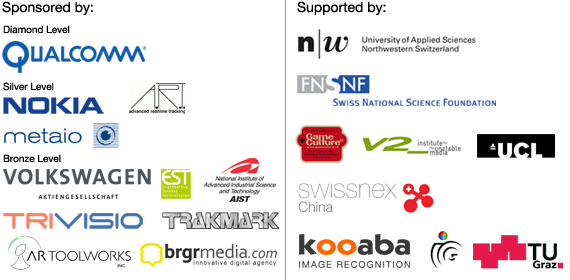Tutorials
For additional information please see the program overview.
26 OCTOBER 2011 |
09:00 - 18:00 |
TUTORIAL 01BUILDING YOUR VISION WITH QUALCOMM’S MOBILE AUGMENTED
|
MEXICO |
Daniel Wagner (Qualcomm Austria Research Center) Tutorial topics:
WEB: www.qualcomm.com/events/international-symposium-mixed-and-augmented-reality-2011/speakers |
|
TUTORIAL 02BI-DIRECTIONAL OLED MICRODISPLAY FOR SEE-THROUGH HMD |
MIAMI |
Uli Bockholt (Fraunhofer IGD) Within the research project “iStar - Interactive See-Through Augmented-Reality Display” the Fraunhofer Gesellschaft developed Augmented Reality goggles comprising a VGA OLED microdisplay with embedded image sensor aimed on gaze-control and see-through head-mounted optics. The active area of the bi-directional microdisplay consists of nested display and image sensor (embedded camera) pixels surrounded by a second image sensor (frame camera) as well as driving and control circuitry (c.f. Table). The display and image sensor systems are electrically independent of one another, simply interacting via synchronization signals. iStar also includes a developer kit integrating Eye-Tracking software, AR system and application demonstrators.
WEB: istar-project.org/ismar2011 |
|
TUTORIAL 03PSYCHOLOGICAL KEYS TO SUCCESS IN MAR SYSTEMS |
HONGKONG |
Mike Neal (Lexical Edge) Imagine a significant improvement in understanding user response to your The purpose of this tutorial is to help define the role psychological research and theories play in the successful development and deployment of commercial MAR applications. It contains four major sections of study for session participants. The first three are: 1) cognitive science, 2) psychological design, and 3) narrative transportation theory for applications. There is considerable research in user experience (UX), and there are many lessons to be learned as MAR technology moves into the mainstream. Each section deconstructs core foundational components in the understanding of user-experience (UX) with regard to new interactive technologies. The final section ties the first three sections together and provides practical tips and techniques to help MAR researchers and practitioners take the psychological sciences into their labs, design, and development shops. Throughout this tutorial, attendees will view various examples of each of the topics, as well as be exposed to a variety of similarities and differences in cognitive interpretation of object and environment design. By the end of this session, attendees will have a better understanding of how to design for diverse end-users, as well as how to capture and hold end-user attention for the ultimate purpose of engagement and immersion. WEB: www.lexicaledge.com/ISMAR2011 |
|
Tutorials Withdrawn:
TUTORIAL 04Multi-sensor Navigation and Trackinghttp://kramian.com/navclass.html |








